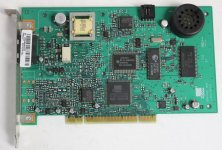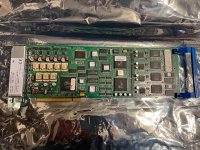famicomaster2
Experienced Member
Hello, I've just yesterday installed Windows Server 2003 and nothing else but a NIC driver and a modem driver.
The modems are internal PCI Lucent 1456VQH-T2s. I have four.
If I install any one of the four modems in any of the six available PCI slots, the modem appears in Device Manager and just works. All four modems can answer and originate data calls without issue.
If I install a second modem in any slot, only one of the two will work. One will operate as normal, answering and originating calls just fine, but the other will display the message "The device cannot start (code 10)" in Device Manager. If I install all four modems, in any arrangement of slots, only one modem ever works. The rest all show this code 10 message.
Reading around, there are no sane answers to this problem that I could find. Some people say to reinstall Windows, but this is a fresh install, completely unused. I haven't even installed a video driver yet.
Some say to update drivers, I'm already running the latest drivers.
Some say hardware failure, I've individually tested all four cards to be functional.
Some say resource conflict. With only two modems, no matter what resource allocation I give the working modem, the second modem never works.
Some say reinstall drivers. I've done this three times and even rolled back to the original Windows driver to no avail.
I've had one person suggest that since these are HCF modems, the driver may simply not support multiple devices, but I was under the impression that Windows ran multiple copies of the driver for multiple devices. This thought could, of course, be wrong. I am not opposed to the idea of replacing these HCF modems with real hardware modems, but I have had difficulty finding reliable information on what PCI modems are hardware vs which are HCF or HSP, and of course what is supported by Server 2003.
I'm at my wit's end here, and so I come seeking advice. Any advice on fixing this issue is appreciated.
The modems are internal PCI Lucent 1456VQH-T2s. I have four.
If I install any one of the four modems in any of the six available PCI slots, the modem appears in Device Manager and just works. All four modems can answer and originate data calls without issue.
If I install a second modem in any slot, only one of the two will work. One will operate as normal, answering and originating calls just fine, but the other will display the message "The device cannot start (code 10)" in Device Manager. If I install all four modems, in any arrangement of slots, only one modem ever works. The rest all show this code 10 message.
Reading around, there are no sane answers to this problem that I could find. Some people say to reinstall Windows, but this is a fresh install, completely unused. I haven't even installed a video driver yet.
Some say to update drivers, I'm already running the latest drivers.
Some say hardware failure, I've individually tested all four cards to be functional.
Some say resource conflict. With only two modems, no matter what resource allocation I give the working modem, the second modem never works.
Some say reinstall drivers. I've done this three times and even rolled back to the original Windows driver to no avail.
I've had one person suggest that since these are HCF modems, the driver may simply not support multiple devices, but I was under the impression that Windows ran multiple copies of the driver for multiple devices. This thought could, of course, be wrong. I am not opposed to the idea of replacing these HCF modems with real hardware modems, but I have had difficulty finding reliable information on what PCI modems are hardware vs which are HCF or HSP, and of course what is supported by Server 2003.
I'm at my wit's end here, and so I come seeking advice. Any advice on fixing this issue is appreciated.





